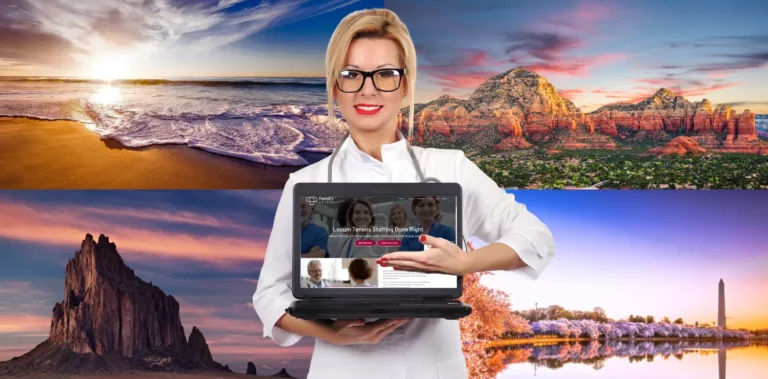Credentialing for locum tenens, the practice where physicians and healthcare professionals fill temporary positions at healthcare facilities, involves a detailed and often rigorous process. This is because locum tenens practitioners must meet the same standards as permanent staff members. The detailed and rigorous credentialing process for locum tenens is crucial in maintaining the quality and safety of patient care. By ensuring that locum tenens practitioners meet the same standards as permanent staff members, healthcare facilities can have confidence in the expertise and qualifications of these temporary providers. This rigorous process helps to establish trust between locum tenens professionals and the healthcare facilities they serve, creating a seamless integration into the healthcare team.
Step-By-Step Locum Tenens Credentialing Process
Here’s an overview of how the credentialing process typically works for locum tenens:
1. Initial Application
The process begins with the locum tenens professional submitting an application to a locum tenens agency or directly to a healthcare facility. This application includes detailed information about their education, training, work history, and any special certifications or qualifications.
2. Verification of Credentials
After the initial application, every piece of information is thoroughly verified. This includes contacting medical schools, previous employers, and references. Special attention is given to verifying medical licenses, board certifications, and any additional qualifications relevant to their specialty.
What Credentialing Documents Are Needed?
In order to ensure a streamlined and successful credentialing process for locum tenens healthcare professionals, it is essential to gather and submit all necessary documentation. These documents can be classified into high-priority and secondary categories.
High-Priority Documents:
- An updated resume or Curriculum Vitae (CV)
- Current and valid state medical licenses
- Current and valid Basic Life Support (BLS), Advanced Cardiac Life Support (ACLS), Advanced Trauma Life Support (ATLS), Pediatric Advanced Life Support (PALS), Advanced Pediatric Life Support (APLS), and Neonatal Resuscitation Program (NRP) certificates.
- Federal Drug Enforcement Administration (DEA) Certificate(s)
- Valid state-controlled substance registrations
- National Provider Identifier (NPI) confirmation letter
- Malpractice claims history
Secondary Documents:
- A current photograph
- A color copy of a valid driver’s license or passport
- Graduate or medical school diploma
- Valid DEA license
- Case logs for the last 24 months (if applicable)
- Educational Commission for Foreign Medical Graduates (ECFMG) certificate
- Continuing medical education (CME) credits earned during the past two years
- Mammography (Mammo) and Mammography Quality Standards Act (MQSA) required documentation (for radiologists, if applicable)
Immunization Records For:
- Hepatitis B
- Influenza
- Measles, Mumps, and Rubella
- Meningococcal disease
- Tetanus, Diphtheria, and Pertussis
- Varicella
In addition to the required documentation, providing professional references is an essential part of the locum tenens credentialing process. Each new facility will seek references from colleagues or supervisors who can speak to your skills, communication, and professionalism. It is important to provide accurate and up-to-date reference information, including their name, contact details, specialty, the period and location of your work together, and the job title and date when you cited them as a reference. Building a strong reference foundation is an opportunity to cultivate positive relationships and enhance your professional reputation.
3. Background Checks
A comprehensive background check is performed, which may include criminal background checks, drug screenings, and a review of any past malpractice claims or disciplinary actions.
4. Privileging
Once credentials are verified, the locum tenens professional must be granted privileges at the healthcare facility where they will be working. This involves a review by the medical staff at the facility, which assesses the provider’s competency and suitability for the specific role they will fill.
5. State Licensing
Since medical licenses are issued at the state level in the United States, locum tenens providers must be licensed in the state where they plan to work. Some states offer temporary or expedited licenses for locum tenens practitioners.
6. Ongoing Credentialing
Credentialing is not a one-time event. Locum tenens professionals must keep their credentials up to date, which includes maintaining their medical license, board certifications, and other necessary qualifications.
7. Compliance with Facility-Specific Requirements
Different healthcare facilities may have their own unique requirements or orientation processes for locum tenens staff. It’s important for providers to be aware of and comply with these additional requirements.
8. Continuous Quality Monitoring
Even after being credentialed, locum tenens professionals are subject to continuous quality monitoring and performance evaluations, similar to permanent staff.
The credentialing process for locum tenens is comprehensive and can take several weeks to months, depending on various factors like the responsiveness of references, the specific requirements of the healthcare facility, and the state licensing procedures. This process ensures that locum tenens providers are well-qualified and ready to provide high-quality patient care in their temporary roles.
Red Flags to Avoid in the Credentialing Process
While your recruiter will take every possible step to prevent any issues during the credentialing process, there are measures you can take to facilitate the process smoothly and efficiently:
1. Ensure Timelines Are Met
Once you have received and accepted your assignment, it is crucial to promptly gather and provide all necessary information to your recruiters and credentialing authorities. Failure to provide complete details in a timely manner can be a significant red flag.
2. Provide Accurate Documentation
Nothing is more frustrating than investing time and effort, both for you and the credentialing authorities, only to encounter major hurdles due to incomplete or incorrect documentation. Ensure all your documents are properly completed, including any required signatures.
3. Provide Valid References
Using outdated reference information can lead to unnecessary complications. It is essential to verify the accuracy of your references’ information prior to each assignment. Additionally, take the opportunity to confirm their availability and willingness to provide a thorough and positive recommendation. If necessary, consider alternative references.
4. Address Past Issues
While it is crucial to provide all pertinent information to your recruiter, it is important to note that past disciplinary actions or extensive liabilities can raise red flags. Trying to conceal such information is not advisable, as it not only reflects negatively on you but also on your recruiter and the recruiting agency.
Pro Tip:
When transitioning to a new assignment in a different state, it is necessary to provide information from your previous location. Whenever possible, work on completing the required paperwork while you are concluding your current assignment. This will streamline the process significantly.
The timeline for the credentialing process can vary from a few days to several months, depending on the specific position and facility. While some hospitals may have more flexibility in filling urgent positions, government facilities often require more rigorous background checks. To simplify the process, ensure that all forms and certificates are completed in advance, and promptly address any follow-up queries to avoid unnecessary delays. Although challenging, the credentialing process is a vital aspect of ensuring the safety of hospitals and patients. Approach it as a necessary challenge that propels you toward your desired destination.
If you have any further questions, please do not hesitate to contact us here.
FAQ
What is locum tenens credentialing?
Locum tenens credentialing is the process by which healthcare professionals who fill temporary positions at healthcare facilities are verified and approved to provide patient care. It ensures that locum tenens practitioners meet the same standards as permanent staff members.
Why is credentialing important for locum tenens professionals?
Credentialing is essential for locum tenens professionals to ensure patient safety and maintain the quality of healthcare services provided. It verifies their qualifications, licenses, certifications, and work history, ensuring they are competent and suitable for temporary roles.
How does the credentialing process work?
The credentialing process typically involves completing an initial application, providing necessary documentation, undergoing background checks, and obtaining privileges at the healthcare facility. It may also require ongoing maintenance of licenses, certifications, and other qualifications.
What documents are required for locum tenens credentialing?
The required documents can vary, but commonly include an updated CV, state medical licenses, life support certifications, DEA certificates, malpractice claims history, references, and more. Each facility may have additional requirements.
How long does the locum tenens credentialing process typically take?
The duration of the credentialing process varies depending on factors such as the responsiveness of references, specific facility requirements, and state licensing procedures. It can range from several weeks to months.
Can locum tenens professionals work in any state without additional licensing?
Most states require locum tenens professionals to be licensed in the state where they plan to work. However, some states offer temporary or expedited licenses specifically for locum tenens practitioners.
What happens if a locum tenens professional has past disciplinary actions or liabilities?
It is important for locum tenens professionals to disclose any past disciplinary actions or liabilities during the credentialing process, as attempting to conceal such information can have negative repercussions. Each situation may be evaluated individually by the healthcare facility.
How can locum tenens professionals make the credentialing process smoother?
Locum tenens professionals should ensure they meet all timelines, provide accurate documentation, verify the availability and accuracy of references, and address any past issues transparently. They can also work on completing paperwork while concluding their current assignment to streamline the transition to a new assignment.
Is credentialing a one-time process for locum tenens professionals?
No, credentialing is an ongoing process for locum tenens professionals. They must keep their credentials up to date, maintain licenses, certifications, and qualifications, and comply with facility-specific requirements throughout their locum tenens career.
What happens after the credentialing process is completed?
After being credentialed, locum tenens professionals are subject to continuous quality monitoring and performance evaluations similar to permanent staff. They are expected to provide high-quality patient care and adhere to the facility’s policies and procedures.
* Remember, specific credentialing requirements may vary depending on the healthcare facility and individual circumstances. It is advisable for locum tenens professionals to consult with their recruiters or credentialing experts for accurate and detailed information based on their specific situation.





